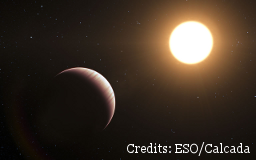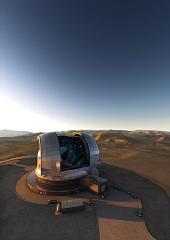Exoplanets and their Atmospheres
The discovery of planets orbiting other stars radically changed our idea of how planetary systems form and evolve. The astonishing diversity of the thousands of exoplanets currently known inspires two fundamental questions: how common is our Solar System? Is there another Earth out there?
I am addressing these questions by studying the atmospheres of exoplanets. I am developing novel and robust observational tools to infer their composition and structure. So far my research has focussed on giant planets orbiting close to their parent stars, called hot Jupiters. In the years to come, thanks to new discoveries and better instruments, smaller and cooler objects will be targeted. Eventually, these observational techniques will be applicable to terrestrial planets to hunt for the signatures of life.
How do we study exoplanet atmospheres? Up to a few years ago, only the atmospheres of transiting planets could be studied. When a planet crosses the disk of its parent star or it is occulted by it, we observe a small decrease in the total light coming from the system. By measuring this dimming at various wavelengths, it is possible to infer the structure and composition of a planet atmosphere, and how the incoming energy from the star gets redistributed.
At very high spectral resolution (R > 20,000), molecular bands are resolved into the individual lines. Each species shows a unique pattern, and this "fingerprint" can be recognised by matching observations with models through cross correlation.  In addition, since planets move along the orbit, their spectrum is subject to a rapidly-changing Doppler shift. Therefore, we can effectively disentangle the signature of an exoplanet from the stationary, dominant absorption of the Earth's atmosphere. With infrared high-resolution spectroscopy, the radial velocity of a transiting planet was measured directly for the very first timeLink opens in a new window, and carbon monoxide was detected in the atmosphere of τ Boötis bLink opens in a new window. Thanks to the direct detection of the planet radial velocity, we can now study the atmospheres of non-transiting planets and estimate their true masses and the orbital inclinationsLink opens in a new window.
In addition, since planets move along the orbit, their spectrum is subject to a rapidly-changing Doppler shift. Therefore, we can effectively disentangle the signature of an exoplanet from the stationary, dominant absorption of the Earth's atmosphere. With infrared high-resolution spectroscopy, the radial velocity of a transiting planet was measured directly for the very first timeLink opens in a new window, and carbon monoxide was detected in the atmosphere of τ Boötis bLink opens in a new window. Thanks to the direct detection of the planet radial velocity, we can now study the atmospheres of non-transiting planets and estimate their true masses and the orbital inclinationsLink opens in a new window.
Multiple molecules, when detected, allow us to put constraints on the elemental abundances of carbon and oxygen (C/O ratioLink opens in a new window), and in general on the planet metallicityLink opens in a new window. With enough planets observed, we hope to unveil the preferential formation mechanism(s) of planets and their primordial location in protoplanetary disks.
Planet rotation, as well as winds, leave a very specific imprint on the shape of the spectral lines. At very high spectral resolution, the broadening and distortion caused by global atmospheric circulation has been detected for both young, giant planetsLink opens in a new window on large orbits and transiting hot JupitersLink opens in a new window.
 The future of high-resolution spectroscopy for exoplanet atmospheres is bright. Modern spectrographs collect more photons and cover a larger fraction of the planet spectrum at once, increasing our sensitivity to smaller and cooler planets. Upcoming missions are also designed to find smaller planets around bright stars, which are ideal candidates for characterisation. Combining other techniques, such as low-resolution spectroscopyLink opens in a new window and direct imagingLink opens in a new window, with high-resolution spectroscopy will drastically improve the measurements of atmospheric parameters in the coming years.
The future of high-resolution spectroscopy for exoplanet atmospheres is bright. Modern spectrographs collect more photons and cover a larger fraction of the planet spectrum at once, increasing our sensitivity to smaller and cooler planets. Upcoming missions are also designed to find smaller planets around bright stars, which are ideal candidates for characterisation. Combining other techniques, such as low-resolution spectroscopyLink opens in a new window and direct imagingLink opens in a new window, with high-resolution spectroscopy will drastically improve the measurements of atmospheric parameters in the coming years.
Eventually, in the era of the Extremely Large Telescope, we will turn our instruments towards terrestrial planets in the habitable zones of M-dwarf stars, looking for potential biomarkers in their atmospheres.
